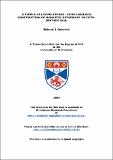A temple of living stones : John Cassian's construction of monastic orthodoxy in fifth-century Gaul
Abstract
This thesis examines John Cassian's attempts to influence the course of Gallic asceticism through the medium of his first ascetic work, De institutis coenobiorum et de octo principalium vitiorum remediis, I-IV. Rather than viewing Cassian as a cloistered, proto-Benedictine monk or an inept monastic legislator, it attempts to locate him in his broader, Late Antique context. The thesis first argues that the traditional view which holds that Cassian was a monk/abbot of Marseilles is flawed; in fact Cassian wrote his ascetic works while living in the province of Narbonensis Secunda and only moved to Marseilles sometime after AD 430. The thesis then turns to a consideration of the strategies Cassian employed to win a hearing for his ascetic works. It examines how he played on his own experience as the quality that gave him the right to overrule both native Gallic ascetic experiments and the works of other western ascetic writers. It also examines how Cassian created a semi-mythical set of monastic laws (the instituta Aegyptiorum) and used this construct as an additional source of authority for his recommendations. Having established Cassian's method for winning a hearing for his work, the thesis then examines what Cassian offered that was in some way different from the practices offered by his contemporaries. The most important difference was Cassian's emphasis on a literal renunciation of all ties with the world before someone could enter the ascetic life. Finally, this thesis argues that a proposal made by Owen Chadwick in 1968, that certain chapters in Book III of De institutis were later forgeries, is indeed correct. This is demonstrated by examining these chapters in the broader context of Cassian's thought and work. This traditional, textual analysis is then followed by a computerized stylometric study of the disputed passages, which confirms the likelihood that these chapters were written by someone other than John Cassian.
Type
Thesis, PhD Doctor of Philosophy
Collections
Items in the St Andrews Research Repository are protected by copyright, with all rights reserved, unless otherwise indicated.

